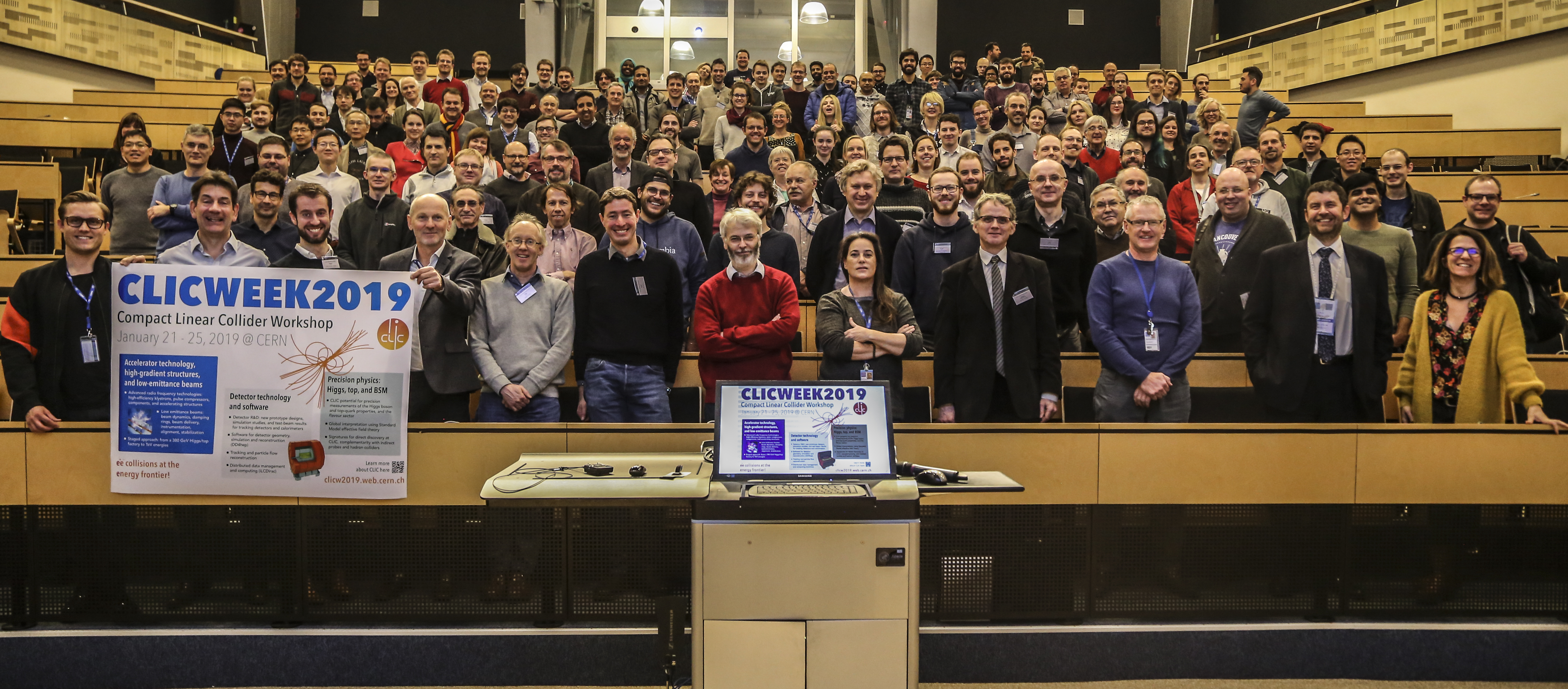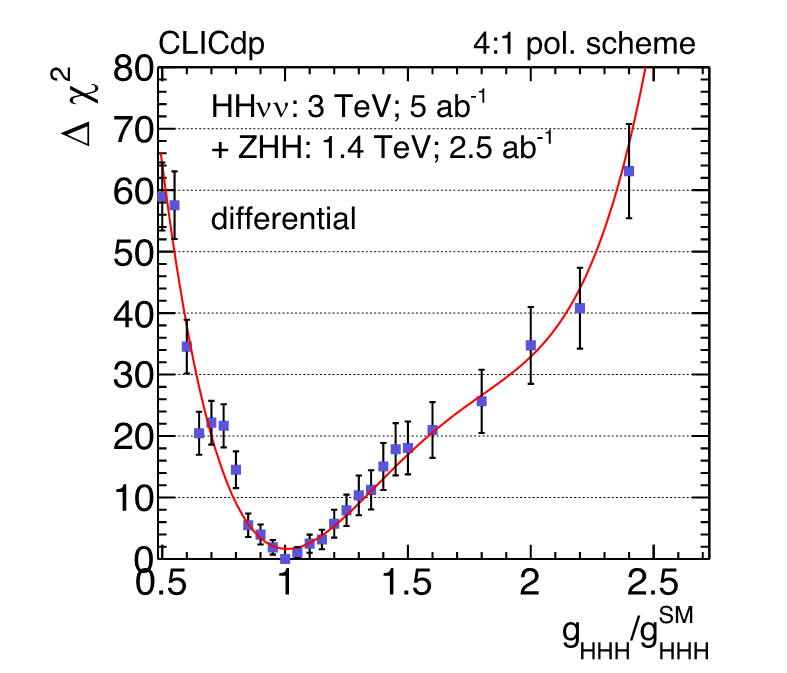A report from the CLIC week

The annual Compact Linear Collider (CLIC) workshop brings together the full CLIC community, this year attracting more than 200 participants to CERN, 21-25 January. CLIC occupies a unique position in both the precision and energy frontiers, combining the benefits of electron-positron collisions with the possibility of multi-TeV collision energies. The CLIC project covers the design and parameters for a collider built and operated in three stages, from 380 GeV to 3 TeV, with a diverse physics programme spanning 30 years. CLIC uses an innovative two-beam acceleration scheme, in which high-gradient X-band accelerating structures are powered via a high-current drive beam, thereby reducing the size and cost of the accelerator complex significantly.
During the opening session, Steinar Stapnes, the CLIC project leader at CERN, reported that the key CLIC concepts such as drive beam production, operation of high-efficiency radio-frequency cavities, and other enabling technologies had all been successfully demonstrated. The afternoon session also included detailed presentations on the accelerator and detector status, and of the CLIC physics potential including key motivations for an electron-positron collider that can be extended to multi-TeV energies.
“The CLIC project offers a cost-effective and innovative technology and is ready to proceed towards construction with a Technical Design Report. Following the technology-driven timeline CLIC would realise electron-positron collisions at 380 GeV as soon as 2035,” says Stapnes.
A major focus in 2018 was the completion of a Project Implementation Plan (PiP) as well as several comprehensive Yellow Reports describing the CLIC accelerator, detector, and detailed physics studies. A central point of these documents was the finalization of a complete cost and power estimation, which for the first stage amount to around 5.9 billion CHF and 168 MW, respectively. These reports were further distilled into the two formal input documents submitted to the European Strategy for Particle Physics Update 2018 - 2020 (ESPP). Looking to the future, the workshop discussed the next important step for the CLIC project: a preparatory phase focusing on large scale tests, industrial production and detailed civil engineering aspects including siting and infrastructure. The goal is to produce a Technical Design Report (TDR), enabling the start of construction for the first CLIC stage by 2026. The CLIC project envisions first beams as early as 2035, thereby offering a competitive timescale for exploratory particle physics for the next generation of scientists.
In the CLIC detector R&D session focusing on silicon pixel technologies, several new and refined test-beam analysis and simulation results were presented. These results enabled the design of two new monolithic detector technology demonstrators targeting the challenging vertex and tracker requirements at CLIC. Final design features for both chips, as well as plans for future tests, were presented and discussed. Many of these tests will take place at the test-beam facilities of DESY in Hamburg, where the CLICdp vertex and tracker group will be welcomed for several weeks during the second planned long shutdown of CERN’s accelerators in 2019/20.
The workshop heard reports on recent developments for measurements of Standard Model processes in the Higgs boson and top-quark sector as well as on the broad sensitivity for direct observation of physics beyond the Standard Model. Updates were presented on benchmark scenarios with challenging signatures such as boosted top quarks and Higgs bosons, produced at the higher-energy stages of CLIC. Further, the Higgs self-coupling, can be directly accessed at the multi-TeV collisions at CLIC through the measurement of double Higgs production. This measurement benefits from the excellent jet resolution and flavour tagging capabilities of the CLIC detector as well as the clean collision environment in electron-positron collisions. The workshop reported projections of the Higgs self-coupling, in a full simulation study, reaching a precision of about 10% (see Figure 1), an accuracy that is preserved in a global fit of the full Higgs programme of CLIC.

Figure 1: Sensitivity to the Higgs self-coupling using double Higgs production from the full CLIC programme. From CLICdp-Note-2018-006/arXiv:1901.05897.
The CLIC physics programme continues to attract interest from the theory community. A series of talks in a dedicated mini-workshop, joint between theorists and experimentalists, reported on the CLIC potential to extend our knowledge of physics beyond the Standard Model. New results were presented showing the CLIC potential to probe the possible composite nature of the Higgs boson at the scale of tens of TeVs (see Figure 2), to discover dark matter candidates such as the thermal Higgsino, and to study axion-like particles in a unique mass range. It was also shown how searching for neutral scalar particles will allow CLIC to explore models relating to the nature of the Electroweak Phase Transition and with non-minimal supersymmetric models addressing the Naturalness Problem. The workshop also saw discussions of first studies of stub-tracks and other long-lived particles searches, a domain in which CLIC has promising potential for future exploration.
Figure 2: 5σ discovery contours for Higgs compositeness in the (m∗,g∗) plane, overlaid with the 2σ projected exclusions from HL-LHC. From CERN-2018-009-M/arXiv:1812.02093.
There is widespread support for a lepton collider that will allow for high-precision Higgs boson and top-quark physics in the post-LHC era. CLIC is a mature contender that in addition can be extended to multi-TeV collisions, providing unique sensitivity to physics beyond the Standard Model.
Further reading:
https://clic.cern/european-strategy
CLIC 2018 Summary Report (CERN-2018-005-M)
CLIC Project Implementation Plan (CERN-2018-010-M)
The CLIC Potential for New Physics (CERN-2018-009-M)
